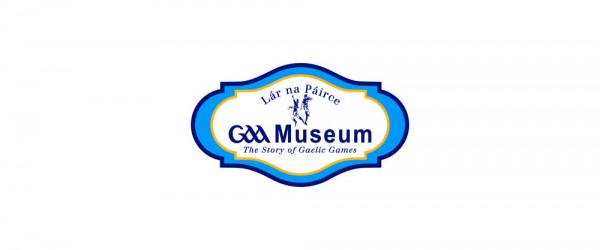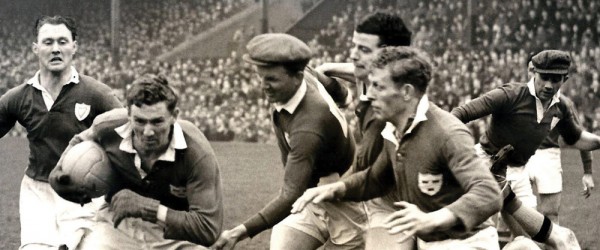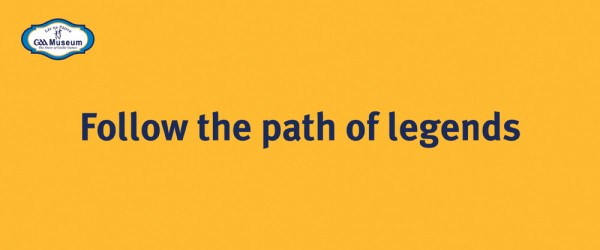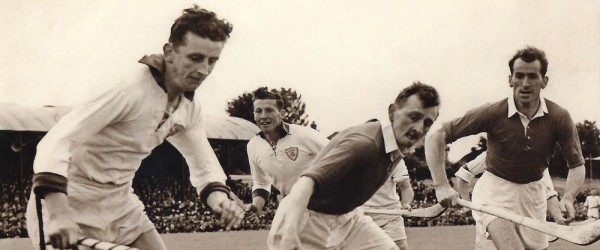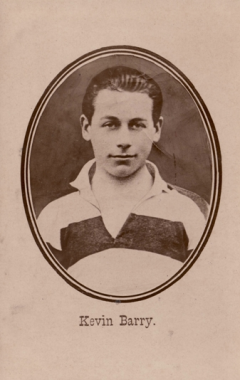When visitors to Lár na Páirce in Thurles speak of their experience at the museum, they invariably remark of their unexpected surprise at seeing Kevin Barry’s hurley. But who was Kevin Barry?
Kevin Barry was born on 20 January 1902 at Fleet Street, Dublin, the fourth of seven children and son of Thomas, a dairyman, and Mary Dowling, both originally from Carlow.
Kevin was educated at several schools in Dublin and Carlow, including Belvedere College. Notwithstanding his many activities, he did not neglect his studies and winning a merit-based scholarship given annually by Dublin Corporation, which allowed him to become a student of medicine at UCD in 1919.
Sport played an important role in Kevin’s life and while at Belvedere College, he was a member of their championship junior rugby cup team. In 1918 he became secretary of the school’s hurling club, which had just been formed and was one of their most enthusiastic players. The attached photograph reputedly depicts Barry wearing a Belvedere College hurling team jersey.
While still at Belvedere, he had joined the Irish Volunteers, established in 1913, initially to ensure the implementation of home rule, but which evolved into the IRA after the commencement of the War of Independence that began in 1919.
Kevin was a member of the first battalion of the Dublin Brigade and took part in two successful raids for arms in Dublin and Wicklow in June and July 1920. The third raid he was involved in occurred on 20 September 1920; it was an attack on British troops at Church Street in Dublin city, aimed at seizing arms. During this unsuccessful raid, firing broke out and three British soldiers of roughly the same age as Barry were killed or fatally wounded and Barry became the first volunteer to be captured in an armed attack since 1916.
Interrogated and mistreated while in custody, he subsequently refused to recognise the court martial that tried him. He was condemned to death on 20 October for murdering the three soldiers and was hanged in Mountjoy Prison, Dublin, on 1 November 1920, by hangman, John Ellis. It was reported that Barry had requested to be shot by firing squad rather than hanged, which he viewed as a death not befitting a soldier.
He was the first person to be tried and executed for a capital offence under the Restoration of Order in Ireland Act, passed 12 weeks before his death, and the first to be executed since May 1916, in the aftermath of the Easter Rising.
This well-known ballad keeps his memory alive and is popular with Irish people everywhere.
Kevin Barry
In Mountjoy jail one Monday morning
High upon the gallows tree,
Kevin Barry gave his young life
For the cause of liberty.
Just a lad of eighteen summers,
Still there’s no one can deny,
As he walked to death that morning,
He proudly held his head on high.
Just before he faced the hangman,
In his dreary prison cell,
British soldiers tortured Barry,
Just because he wouldn’t tell.
The names of his brave comrades,
And other things they wished to know.
‘Turn informer and we’ll free you’
Kevin Barry answered, ‘No’.
Calmly standing to attention
While he bade his last farewell
To his broken hearted mother
Whose grief no one can tell.
For the cause he proudly cherished
This sad parting had to be
Then to death walked softly smiling
That old Ireland might be free.
Another martyr for old Ireland,
Another murder for the crown,
Whose brutal laws to crush the Irish,
Could not keep their spirit down.
Lads like Barry are no cowards.
From the foe they will not fly.
Lads like Barry will free Ireland,
For her sake they’ll live and die.
Twitter Ads info and privacy
